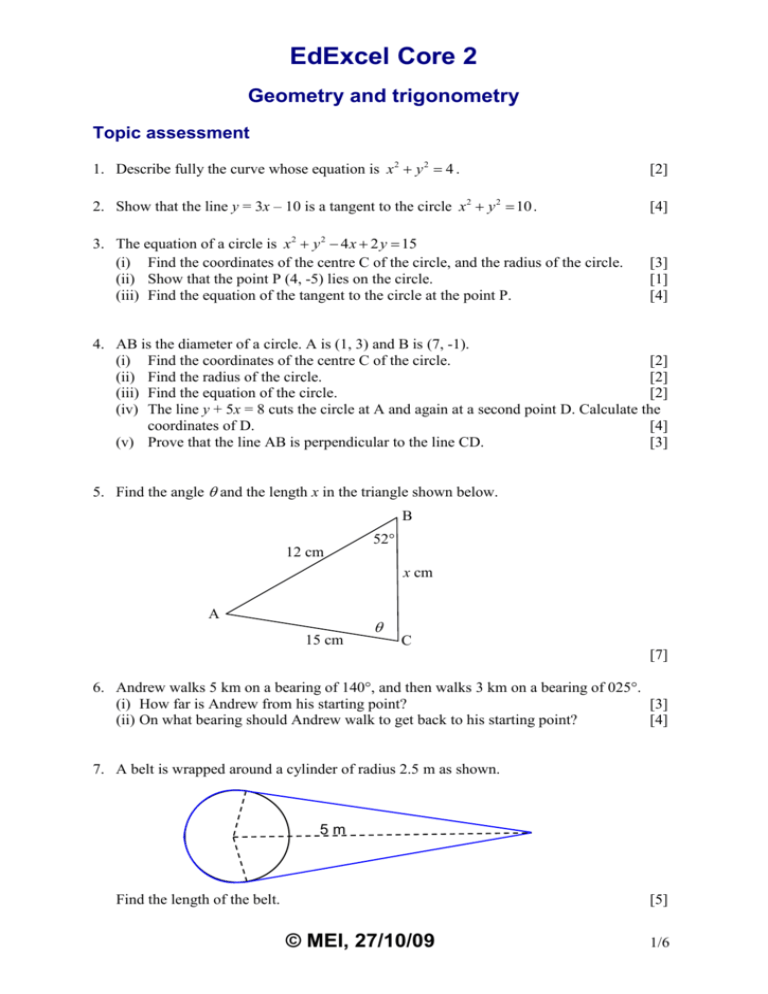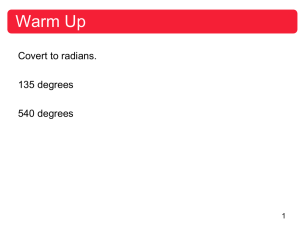EdExcel C2 Geometry & Trigonometry Topic Assessment
advertisement

EdExcel Core 2 Geometry and trigonometry Topic assessment 1. Describe fully the curve whose equation is x 2 y 2 4 . [2] 2. Show that the line y = 3x – 10 is a tangent to the circle x 2 y 2 10 . [4] 3. The equation of a circle is x 2 y 2 4 x 2 y 15 (i) Find the coordinates of the centre C of the circle, and the radius of the circle. (ii) Show that the point P (4, -5) lies on the circle. (iii) Find the equation of the tangent to the circle at the point P. [3] [1] [4] 4. AB is the diameter of a circle. A is (1, 3) and B is (7, -1). (i) Find the coordinates of the centre C of the circle. [2] (ii) Find the radius of the circle. [2] (iii) Find the equation of the circle. [2] (iv) The line y + 5x = 8 cuts the circle at A and again at a second point D. Calculate the coordinates of D. [4] (v) Prove that the line AB is perpendicular to the line CD. [3] 5. Find the angle and the length x in the triangle shown below. B 52° 12 cm x cm A 15 cm C [7] 6. Andrew walks 5 km on a bearing of 140°, and then walks 3 km on a bearing of 025°. (i) How far is Andrew from his starting point? [3] (ii) On what bearing should Andrew walk to get back to his starting point? [4] 7. A belt is wrapped around a cylinder of radius 2.5 m as shown. 5m Find the length of the belt. [5] © MEI, 27/10/09 1/6 EdExcel C2 Geometry & trig Assessment solutions 8. Find the perimeter and area of the shaded sections of these shapes. (i) 3 cm 60° [7] (ii) 8 cm 45° 10 cm [7] Total 60 marks © MEI, 27/10/09 2/6 EdExcel C2 Geometry & trig Assessment solutions Geometry and trigonometry Solutions to Topic assessment 1. The curve is a circle, centre O and radius 2. [2] 2. Substituting y 3 x 10 into x 2 y 2 10 gives x 2 (3 x 10)2 10 x 2 9 x 2 60 x 100 10 10 x 2 60 x 90 0 x 2 6x 9 0 ( x 3)2 0 Since the equation has a repeated root, the line meets the circle just once, and so the line is a tangent to the circle. [4] 3. (i) x 2 y 2 4 x 2 y 15 x 2 4 x y 2 2 y 15 ( x 2)2 4 ( y 1)2 1 15 ( x 2)2 ( y 1)2 20 The centre C of the circle is (2, -1) and the radius is 20 . [3] (ii) Substituting x = 4 and y = -5: (4 2) ( 5 1) 4 16 20 so the point (4, -5) lies on the circle. 2 2 [1] 1 ( 5 ) 4 2 24 2 Tangent at P is perpendicular to CP, so gradient of tangent 21 . Equation of tangent is y ( 5 ) 21 ( x 4) (iii)Gradient of CP 2( y 5 ) x 4 2 y 10 x 4 2 y x 14 [4] 4. (i) C is the midpoint of AB. 1 7 3 ( 1) C , (4, 1) 2 2 [2] (ii) Radius of circle = CA (4 1) (1 3) 2 2 9 4 13 (iii) Equation of circle is ( x 4) ( y 1) 13 [2] [2] © MEI, 27/10/09 3/6 2 2 EdExcel C2 Geometry & trig Assessment solutions (iv) Substituting y 5 x 8 into equation of circle: ( x 4)2 ( 5 x 8 1)2 13 ( x 4)2 ( 5 x 7)2 13 x 2 8 x 16 25 x 2 70 x 49 13 26 x 2 78 x 52 0 x 2 3x 2 0 ( x 1)( x 2) 0 x 1 or x 2 x = 1 is point A, so point D is x = 2 When x = 2, y 5 2 8 2 The coordinates of D are (2, -2) 3 ( 1) 4 2 17 6 3 1 ( 2) 3 Gradient of CD 42 2 [4] (v) Gradient of AB Gradient of AB × gradient of CD so AB is perpendicular to CD. 2 3 1 3 2 [3] 5. Using the sine rule: sin sin 52 12 15 12 sin 52 sin 15 39.1 or 140.9 The value of cannot be 149.0° as the total of the angles would be greater than 180°. So 39.1 . Angle A 180 52 39.08 88.92 x 15 Using the sine rule: sin 88.92 sin 52 15 sin 88.92 x 19.0 cm sin 52 © MEI, 27/10/09 [7] 4/6 EdExcel C2 Geometry & trig Assessment solutions 6. x B O 25° 40° 25° 3 5 40° A (i) Using the cosine rule: x 2 5 2 3 2 2 3 5 cos 65 x 4.62 km [3] 4.6175 3 5 2 3 4.6175 78.9 Bearing 180 25 78.9 (ii) Using the cosine rule: cos 2 2 2 283.9 [4] 7. cos Adjacent 2.5 1 Hypotenuse 5 2 x 2.5 60 Angle of arc with belt on = 360 60 60 240 4 240 240 180 3 4 10 Arc length r 2.5 3 3 tan 5 x 2.5 x 2.5 tan 60 10 2x 3 10 5 tan 60 3 19.1 m(3 s.f.) Total length of belt [5] 8. (i) If the triangle has an angle of 60 at the centre of the circle then it must be an equilateral triangle and so part of the perimeter is 3cm. © MEI, 27/10/09 5/6 EdExcel C2 Geometry & trig Assessment solutions 60 60 180 3 Arc length r 3 3 Perimeter ( 3) cm 6.14 cm (3 s.f.) 3 3 2 Area Area of sector Area of triangle 3 1 3 3 sin 60 2 2 0.815 cm 2(3 s.f.) Area of sector 21 r 2 0.5 32 [7] (ii) Arc length = r Sector area = 21 r 2 45 45 Sector 1: 180 4 Arc length 10 Sector area Sector 2: 1 2 Arc length 8 4 5 2 10 2 4 4 25 2 2 Sector area 21 8 2 4 8 Shaded area: Perimeter 2 2 Arc length 1 Arc length 2 5 4 2 2 18.1 cm (3 s.f.) Area Area of sector 1 Area of sector 2 25 8 2 14.1 cm 2(3 s.f.) [7] © MEI, 27/10/09 6/6






